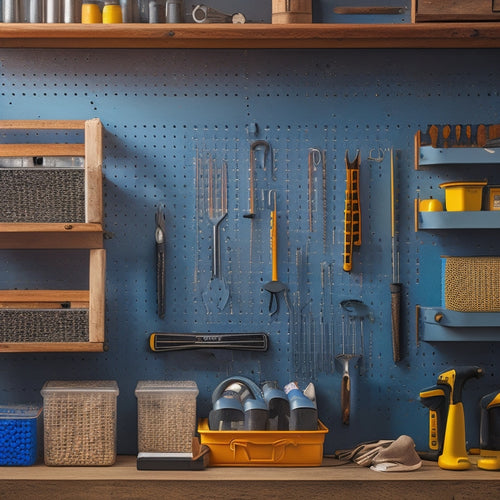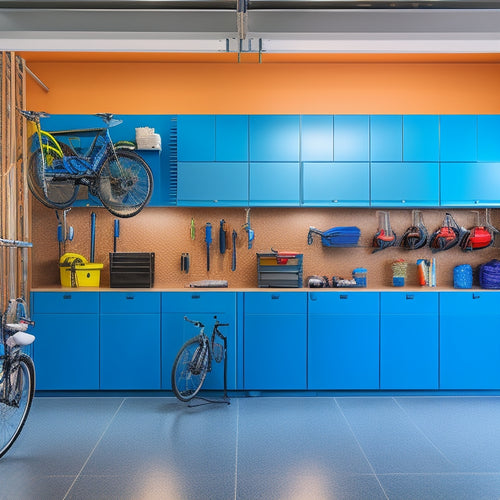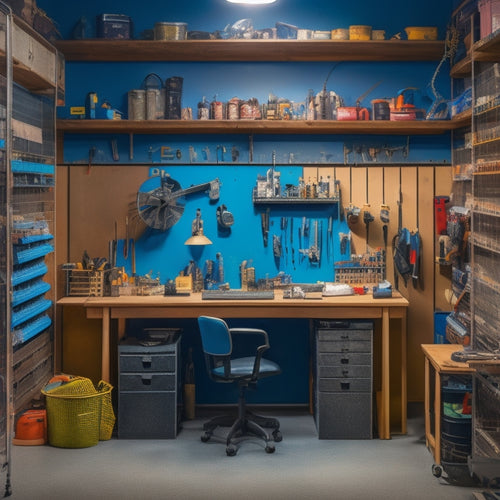
Creative Shop Organization Ideas to Boost Productivity
Share
You're about to transform your shop into a productivity powerhouse by implementing creative organization ideas that optimize your workflow, maximize storage space, and minimize clutter. Start by decluttering your shop with a "one in, one out" policy and categorizing items into essential and non-essential. Next, maximize your vertical storage space with adjustable shelves, hooks, and bins, and employ tool chests to keep tools organized and visible. Customized workstation solutions, essential tool organization ideas, and smart inventory management systems will further enhance your productivity. By streamlining workflow processes, you'll identify bottlenecks and automate repetitive tasks, and with these creative solutions, you'll reveal even more ways to amplify your shop's efficiency.
Key Takeaways
- Implement a minimalist approach by identifying essential vs. non-essential items to declutter the shop and increase productivity.
- Utilize vertical storage solutions like wall-mounted pegboards, bins, and shelves to maximize storage space and reduce clutter.
- Create efficient desk layouts with task-based zones and the "golden triangle" concept to minimize distractions and enhance productivity.
- Categorize and organize tools using storage bins, labeling systems, and mobile carts to reduce frustration and improve accessibility.
- Establish a smart inventory management system to track stock, identify trends, and facilitate data-driven decision-making.
Decluttering Strategies for Success
How do you know when it's time to declutter your shop? It's time when you're wasting precious time searching for misplaced tools, tripping over cluttered aisles, or feeling overwhelmed by the sheer amount of stuff in your workspace.
A cluttered shop can lead to safety hazards, decreased productivity, and increased stress levels.
To combat this, adopt a minimalist approach to decluttering. Start by identifying essential items and separating them from non-essential ones. Be ruthless – if you haven't used it in the past year, it's likely you won't miss it.
Implement a "one in, one out" policy to maintain a clutter-free mindset. This means that for every new item you bring into your shop, an old one must be removed.
Sort items into categories, such as tools, materials, and supplies. Assign a designated space for each category, and make sure everything has a clear and accessible home.
Labeling storage bins and shelves can help you quickly identify what's inside, saving you time and effort.
Maximizing Vertical Storage Space
You'll get the most out of your shop's storage capacity by optimizing shelf heights to match the items you need to store, ensuring that every inch of vertical space is used efficiently.
By doing so, you'll be able to fit more items in a smaller footprint, keeping your workspace clutter-free and organized.
Additionally, don't forget to employ wall space by installing hooks, bins, or shelves to store items that are less frequently used, keeping them out of the way but still accessible.
Optimize Shelf Heights
What's the secret to fitting more into your shop without sacrificing significant floor space? It's optimizing your shelf heights. By doing so, you'll maximize your storage capacity while maintaining a safe and accessible working environment.
Start by taking precise shelf measurements to determine the ideal height for each shelf. Consider installing adjustable shelves to accommodate items of varying sizes. This flexibility will enable you to store more items while keeping frequently used tools within easy reach, ensuring height accessibility.
When arranging your shelves, group similar items together and label each shelf with organizational labels. This will help you quickly locate specific tools and materials, saving you time and reducing clutter.
Utilize Wall Space
By maximizing your shelf heights, you've created a solid foundation for your shop's organization. Now, it's time to take it to the next level by utilizing your wall space. This often-overlooked area can become a beneficial storage hub, freeing up floor space and streamlining your workflow.
Start by installing wall-mounted pegboards, which can hold everything from tools to accessories. This will keep frequently used items within easy reach, reducing the time spent searching for them.
You can also use magnetic strips to store metal items like wrenches, pliers, or screwdrivers. This will keep them organized, prevent them from getting lost, and make them easy to grab when needed.
Additionally, consider adding hooks, bins, or baskets to store items like cords, safety gear, or cleaning supplies. By making the most of your wall space, you'll be able to maintain a clutter-free shop, reduce tripping hazards, and create a safer working environment.
With a little creativity, you can turn your walls into a productivity powerhouse.
Customized Workstation Solutions
You'll enhance productivity by creating an efficient desk layout that minimizes clutter and keeps essential tools within easy reach.
By setting up task-based zones, you'll be able to focus on specific tasks without distractions, and ergonomic accessories will help reduce fatigue and discomfort.
As you design your customized workstation, consider how you can optimize each element to support your unique workflow and needs.
Efficient Desk Layout
Optimizing your workspace begins with a well-designed desk layout, customized to your unique needs and workflow. By implementing efficient desk arrangement tips, you'll create a harmonious workspace that elevates your creativity and productivity.
Start by evaluating your workflow and identifying the tools and materials you use most frequently. Place these items within easy reach to minimize distractions and reduce the risk of accidents.
Consider the "golden triangle" concept, where your most-used items form the points of a triangle, with your body at the center. This layout guarantees you're not stretching or straining, promoting a safe and comfortable working environment.
Next, focus on workspace aesthetics. A clutter-free desk and organized storage promote a sense of calm, allowing you to focus on the task at hand.
Invest in desk organizers, trays, and bins to keep essential items tidy and out of the way. By doing so, you'll create a visually appealing workspace that inspires creativity and amplifies your overall productivity.
Task-Based Zones
A well-designed workstation consists of task-based zones, each customized to a specific activity or function. This setup allows you to efficiently switch between tasks, reducing changeover time and increasing productivity.
By dedicating a particular area to a specific task, you can focus on the task at hand without distractions.
When designing your task-based zones, consider the following benefits:
-
Streamlined project collaboration: Designate a zone for team brainstorming and project collaboration, equipped with whiteboards, sticky notes, and comfortable seating.
-
Efficient tool access: Create a zone for tool storage and maintenance, keeping frequently used tools within easy reach.
-
Concentrated work areas: Set up a quiet, distraction-free zone for focused work, free from interruptions and noise.
Ergonomic Accessories
Your workstation's ergonomic accessories can make all the difference in your productivity and comfort. By incorporating customized solutions, you'll reduce the risk of injury, alleviate discomfort, and stay focused on the task at hand.
Consider investing in a standing desk or a sit-stand workstation to alternate between sitting and standing throughout the day. Add wrist supports to your keyboard and mouse to prevent strain and discomfort. Monitor risers will help you find the perfect viewing angle, while cable management systems will keep your workspace organized and clutter-free.
Don't forget about the importance of floor-level ergonomics. Chair mats and anti-fatigue mats will provide comfort and support for your feet and legs, while footrests will help maintain good posture.
Keyboard trays and desk organizers will keep your workspace tidy and your essentials within reach. Finally, incorporate posture notifications, such as a desktop alert or a wearable device, to guarantee you're maintaining good posture throughout the day.
Essential Tool Organization Ideas
As you begin to tackle the task of organizing your shop, it's vital to start with the tools you use most frequently.
By implementing a tool categorization system, you can group similar tools together, making them easily accessible when you need them. This will save you time and reduce frustration.
Here are three essential tool organization ideas to get you started:
-
Label and Contain: Use storage bins and labeling systems to keep tools off the floor and out of the way. This will prevent tripping hazards and keep your workspace clean.
-
Mobilize Your Tools: Invest in mobile carts, drawer organizers, and tool trays to keep frequently used tools within easy reach. This will reduce walking distances and increase productivity.
-
Optimize Your Walls: Employ pegboard systems, magnetic strips, and tool chests to maximize your shop's vertical space. This will keep your tools organized, visible, and easily accessible.
Smart Inventory Management Systems
Smart inventory management is the backbone of an organized shop, allowing you to keep track of your stock, identify trends, and make informed purchasing decisions. A well-implemented system helps you stay on top of your inventory, reducing the risk of stockouts, overstocking, and wastage.
With automated tracking, you can easily monitor your inventory levels, receive alerts when items need to be replenished, and optimize your storage space.
Data analysis is a vital aspect of smart inventory management. By analyzing your inventory data, you can identify patterns, trends, and areas for improvement. This information enables you to make data-driven decisions, such as adjusting your stock levels, streamlining your supply chain, and optimizing your pricing strategy.
A smart inventory management system also helps you maintain a safe and organized workspace by reducing clutter, improving accessibility, and minimizing the risk of accidents.
Streamlining Workflow Processes
Nearly 60% of a shop's day is spent on workflow processes, making them a critical area for optimization. You know that a single bottleneck can bring your entire operation to a grinding halt.
That's why streamlining your workflow processes is essential to enhancing productivity and staying ahead of the competition.
To get started, try these three strategies to revolutionize your workflow:
-
Map your processes: Take a closer look at every step involved in your workflow. Identify areas where tasks can be combined, eliminated, or automated. Process mapping helps you visualize your workflow, making it easier to spot inefficiencies and opportunities for improvement.
-
Automate repetitive tasks: Workflow automation can save you a significant amount of time and reduce the risk of human error. Look for tasks that can be automated, such as data entry, report generation, or inventory management.
-
Implement a "one-touch" rule: Encourage your team to handle each task or project in a single session, eliminating the need for unnecessary back-and-forth or revisits. This approach helps maintain momentum and keeps your workflow moving at a steady pace.
Frequently Asked Questions
How Do I Prevent Clutter From Building up Again After Organizing?
To prevent clutter from building up again, you'll develop good organization habits by implementing clutter management strategies, like scheduling regular tidying sessions, assigning a home for each item, and maintaining a "one in, one out" policy to keep your space organized and clutter-free.
Can I Use DIY Storage Solutions in a Small Shop Space?
Savvy shoppers, scouring for space-saving solutions, can undoubtedly craft DIY storage systems in small shop spaces. Opt for multi-functional furniture, like foldable workbenches or wall-mounted shelves, to maximize efficiency and minimize clutter, ensuring a safe and organized work environment.
Are There Any Eco-Friendly Shop Organization Materials Available?
You'll find eco-friendly shop organization materials that prioritize safety and sustainability, such as sustainable shelving made from reclaimed wood and biodegradable bins crafted from natural resources, allowing you to maintain a clutter-free space while reducing your environmental footprint.
How Often Should I Clean and Maintain My Shop Organization System?
You should establish a regular cleaning schedule to maintain your shop organization system, dedicating time daily, weekly, and monthly to tasks like dusting, disinfecting, and inventory checks, following maintenance tips to guarantee a safe and efficient workspace.
Can I Customize Shop Organization Solutions for Left-Handed Workers?
When designing your workspace, you'll want to contemplate left-handed tools and ergonomic layouts that cater to your unique needs, ensuring a comfortable and safe working environment that enhances your productivity and reduces fatigue.
Conclusion
With your creative shop organized and humming like a well-oiled machine, you're now ready to tackle even the most complex projects with ease. Every tool is within arm's reach, every workstation is customized to your needs, and every inch of storage space is maximized. As you work, imagine your productivity soaring like a bird set free, unencumbered by clutter and inefficiency. With these shop organization ideas, you'll be flying high in no time!
Related Posts
-

What to Look for in a Pegboard Tool Storage Kit
When shopping for a pegboard tool storage kit, you need a system that combines customized organization, sturdy durabi...
-

Top Garage Storage Bins for Organization and Style
You can enhance your garage's style and organization with the right storage bins. Top brands like Rubbermaid, Suncast...
-

3 Key Steps to Streamline Your Workshop Organization
You're likely wasting 30% of your workshop's productivity and profitability due to disorganization, a common problem ...


